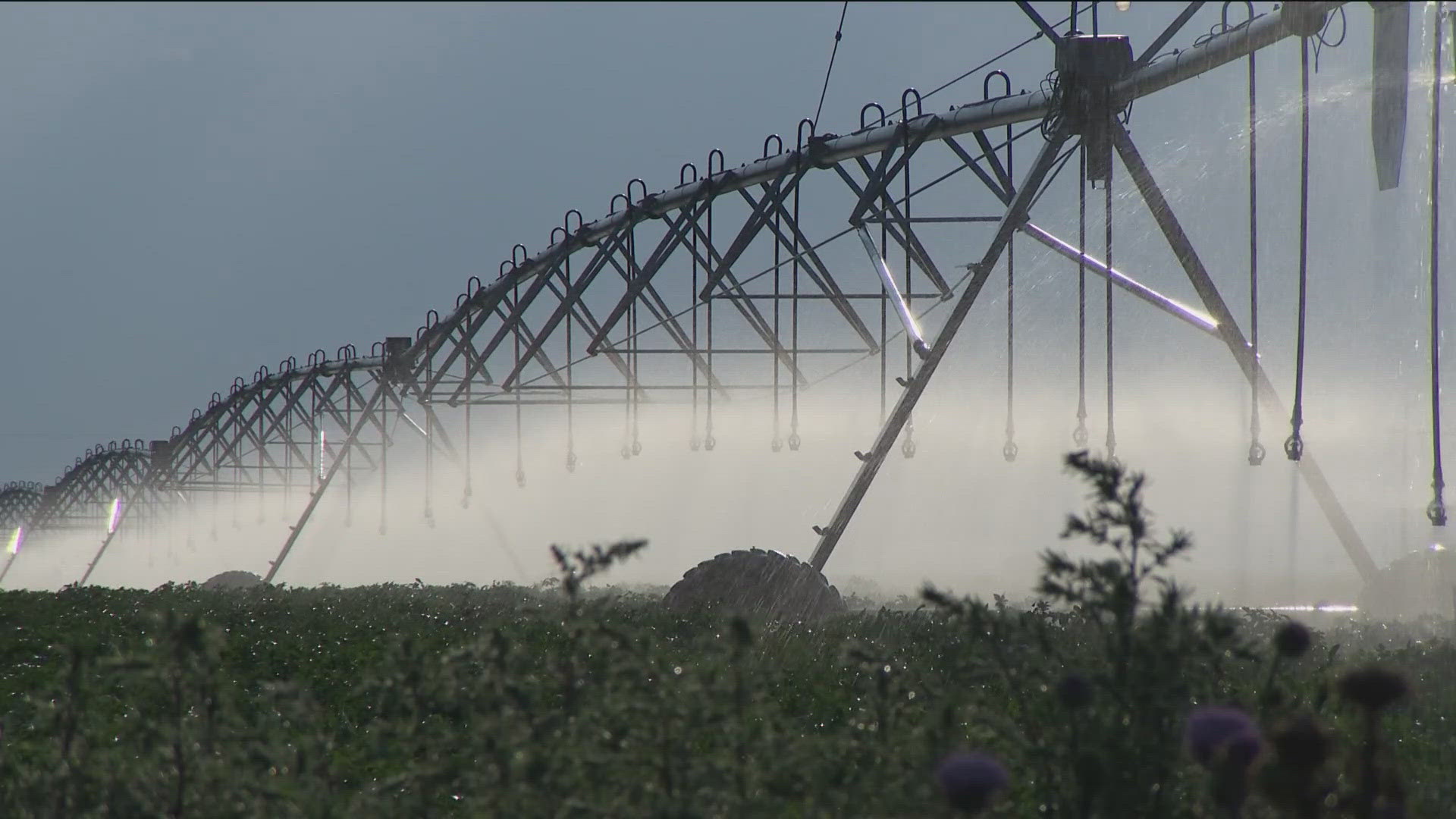Report on Idaho’s Water Supply Status and Implications for Sustainable Development
Executive Summary
A rapid and significant decline in precipitation from April to June has drastically altered Idaho’s water supply outlook for the year. Initial optimism, based on strong snowpack and reservoir carryover, has been replaced by concerns of widespread drought and potential water shortages, particularly within the Snake River Basin. This situation presents a direct challenge to the state’s progress toward several key United Nations Sustainable Development Goals (SDGs), including those related to water security, food production, and climate resilience.
Current Hydrological Conditions
An analysis by the Idaho Department of Water Resources reveals a dramatic shift in environmental conditions over the past three months. This rapid deterioration highlights the state’s vulnerability to climatic changes and its impact on essential resources.
- Precipitation Anomaly: The state received only 56% of normal precipitation between April and June.
- Historical Context: This period ranks as the fifth driest April-June on record.
- Impact on Outlook: What was projected to be a strong water year has now become a significant concern, demonstrating the volatility of water resources and the need for adaptive management aligned with SDG 13 (Climate Action).
Impact Assessment on Key River Basins
The effects of the dry conditions are not uniform across the state, with the largest river system facing the most immediate threat.
The Snake River Basin
As the state’s primary water system, the Snake River Basin is experiencing accelerated depletion of its reservoirs. Hydrologists project that this will lead to water shortages by late summer, directly impacting the state’s ability to meet targets for SDG 6 (Clean Water and Sanitation).
- Reservoirs are being drawn down faster than anticipated.
- Water shortages for users in the Snake River system are predicted by August or September.
Boise, Payette, and Owyhee Reservoir Systems
These systems are currently in a more stable condition due to substantial reservoir carryover from the previous year. However, this stability is temporary. It is projected that these systems will end the current season with minimal carryover, heightening the risk of shortages next year and increasing the region’s dependency on an above-average precipitation season to ensure future water security.
Implications for Sustainable Development Goals (SDGs)
The current water situation in Idaho has profound implications for the achievement of global sustainability targets at a regional level.
- SDG 6: Clean Water and Sanitation: The predicted shortages directly threaten the goal of ensuring sustainable water management and availability for all users, including agricultural, industrial, and domestic sectors.
- SDG 2: Zero Hunger: Water scarcity poses a direct risk to agricultural productivity. Potential curtailments for farmers and ranchers could impact food production, affecting livelihoods and regional food security.
- SDG 13: Climate Action: The rapid shift from a water-abundant to a water-scarce scenario exemplifies the climate volatility that communities must adapt to. It underscores the urgent need for resilient water infrastructure and management strategies.
- SDG 15: Life on Land: Reduced water levels in rivers and reservoirs can degrade aquatic and riparian habitats, impacting biodiversity and the overall health of ecosystems dependent on these water sources.
Recommendations and Outlook
The immediate future of Idaho’s water supply is contingent upon summer weather patterns and proactive management by water users. The following actions are recommended:
- Conservation Mandate: Water users, especially those reliant on storage from reservoirs, are strongly encouraged to implement conservation measures immediately to extend the availability of the current supply.
- Strategic Planning: Stakeholders must prepare for a scenario of low reservoir carryover into the next water year, necessitating early and collaborative planning.
- Enhanced Monitoring: Continued monitoring of climatic conditions and their impact on the water supply is critical for informed and timely decision-making to mitigate adverse effects on communities and the economy.
The situation remains fluid, and the decisions made by farmers, water managers, and communities in the coming months will be critical in navigating the challenges posed by these drought conditions.
Analysis of Sustainable Development Goals in the Article
1. Which SDGs are addressed or connected to the issues highlighted in the article?
The article on potential water shortages in Idaho’s Snake River Basin connects to several Sustainable Development Goals (SDGs) that address water scarcity, its impact on human activities, and the environment.
- SDG 6: Clean Water and Sanitation – This is the most direct SDG, as the article’s central theme is the management and potential scarcity of freshwater resources.
- SDG 2: Zero Hunger – The article mentions the potential impact on agriculture, linking water availability to food production.
- SDG 13: Climate Action – The water shortage is attributed to extreme weather patterns, specifically a record dry period, which is a climate-related hazard.
- SDG 15: Life on Land – The health of the Snake River system, a major freshwater ecosystem, is under threat, which relates to the protection of terrestrial and inland freshwater ecosystems.
2. What specific targets under those SDGs can be identified based on the article’s content?
SDG 6: Clean Water and Sanitation
- Target 6.4: By 2030, substantially increase water-use efficiency across all sectors and ensure sustainable withdrawals and supply of freshwater to address water scarcity.
- The article highlights the need to address water scarcity, with hydrologists predicting “potential water shortages in the Snake River system.” The advice to “stretch that water as far as you can go” is a direct call for increased water-use efficiency among all users.
- Target 6.5: By 2030, implement integrated water resources management at all levels.
- The involvement of “Idaho’s water managers” and the “Idaho Department of Water Resources Hydrologist” in monitoring snowpack, reservoir levels, and precipitation demonstrates the practice of integrated water resources management at a state and basin level (e.g., Snake, Boise, Payette, and Owyhee systems).
SDG 2: Zero Hunger
- Target 2.4: By 2030, ensure sustainable food production systems and implement resilient agricultural practices that… strengthen capacity for adaptation to climate change, extreme weather, drought…
- The article points to the vulnerability of agriculture by stating that “tough decisions lie ahead for farmers.” This implies that the current drought conditions are threatening the sustainability of food production and testing the resilience of agricultural practices in the region.
SDG 13: Climate Action
- Target 13.1: Strengthen resilience and adaptive capacity to climate-related hazards and natural disasters in all countries.
- The article describes a climate-related hazard: one of the “driest on record” periods. The discussion of relying on “reservoir carryover” from previous years is a measure of adaptive capacity, while the warning that the region would “need an above-average season next year to avoid problems” shows the limits of that resilience.
SDG 15: Life on Land
- Target 15.1: By 2020, ensure the conservation, restoration and sustainable use of terrestrial and inland freshwater ecosystems and their services…
- The focus on the Snake River system, which is “feeling the squeeze as reservoirs drop faster than expected,” directly relates to the sustainable use and health of an inland freshwater ecosystem. The predicted shortages threaten the entire basin.
3. Are there any indicators mentioned or implied in the article that can be used to measure progress towards the identified targets?
Indicators for SDG 6
- Indicator 6.4.2: Level of water stress: freshwater withdrawal as a proportion of available freshwater resources.
- This indicator is strongly implied. The article provides data points that define water stress: receiving “only 56% of normal precipitation,” reservoirs dropping “faster than expected,” and the system “not full” at the start of the drawdown. These factors collectively describe a high level of water stress.
Indicators for SDG 2
- The article implies a future negative impact on agricultural production but does not provide a specific indicator. The “tough decisions lie ahead for farmers” suggests a potential future decline in agricultural output or a change in crop patterns, which could serve as indicators.
Indicators for SDG 13
- The occurrence of the drought itself (“fifth driest April-June period on record”) serves as an indicator of a climate-related hazard. The reliance on “reservoir carryover” is a qualitative indicator of the state’s current adaptive strategies.
Indicators for SDG 15
- The physical state of the Snake River system serves as an indicator. Dropping reservoir levels and predicted water shortages are direct measures of the stress on this freshwater ecosystem.
4. Summary Table of SDGs, Targets, and Indicators
| SDGs | Targets | Indicators Identified in the Article |
|---|---|---|
| SDG 6: Clean Water and Sanitation | 6.4: Increase water-use efficiency and address water scarcity.
6.5: Implement integrated water resources management. |
Implied Indicator 6.4.2 (Level of water stress): Measured by low precipitation (56% of normal), dropping reservoir levels, and predicted shortages. |
| SDG 2: Zero Hunger | 2.4: Ensure sustainable food production and resilient agricultural practices against drought. | Qualitative Indicator: The potential for “tough decisions” for farmers, indicating a threat to agricultural sustainability. |
| SDG 13: Climate Action | 13.1: Strengthen resilience and adaptive capacity to climate-related hazards. | Qualitative Indicator: The occurrence of a record dry period (“fifth driest”) and the use of “reservoir carryover” as an adaptation strategy. |
| SDG 15: Life on Land | 15.1: Ensure the sustainable use of inland freshwater ecosystems. | Qualitative Indicator: The physical condition of the Snake River system, which is “feeling the squeeze” due to dropping water levels. |
Source: ktvb.com







